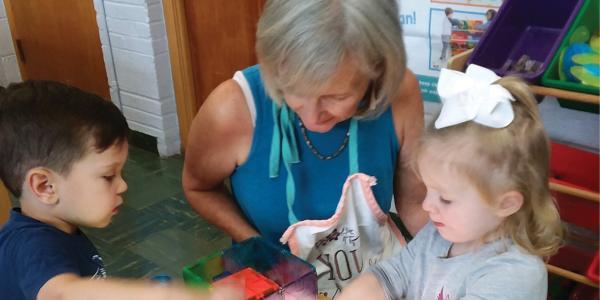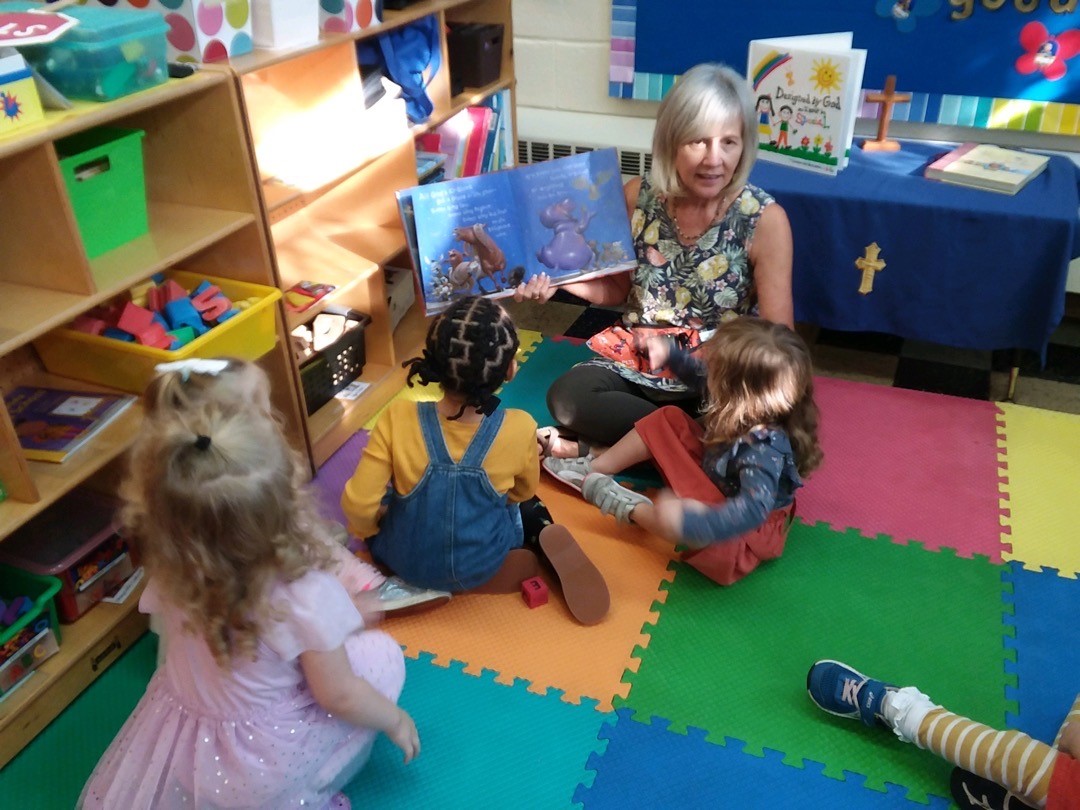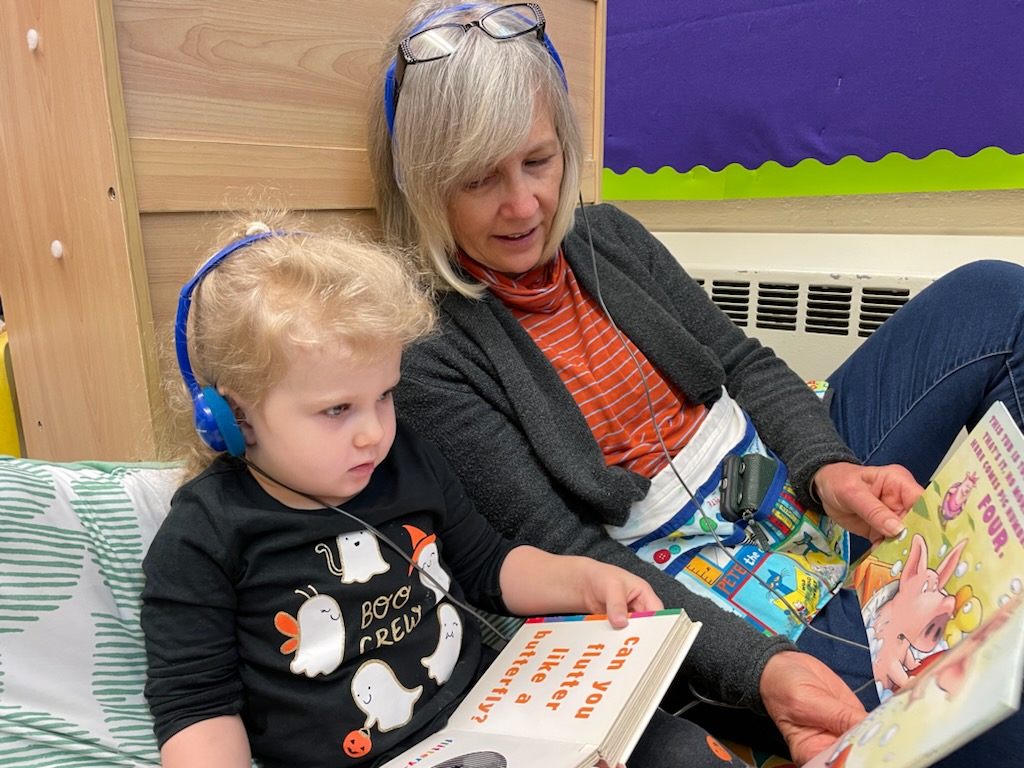Feature Teacher: Bonnie Sears

You are here
Bonnie Sears is director and lead teacher at Grace Preschool in Lakewood, Ohio. She has been an early childhood educator for 25 years.
Tell us about yourself!
I began my career in early childhood education as an instructor for family-child creative play and play gym classes. I worked with both preschoolers and their family members, setting up activity stations, doing music and movement activities, and leading a simple circle time. In addition, I have worked with toddlers and served as an administrator in several early learning programs. I enjoyed taking on a leadership role, but I really missed teaching. So when I was asked to open up Grace Preschool in Lakewood, Ohio, I jumped at the chance. I have served as director and lead teacher there since 2008. I have been married for 44 years and have three grown children and six grandchildren. I enjoy hiking, biking, and painting in my free time.
What is something important a child has taught you?
 I have learned to never underestimate children’s creativity or abilities. I love watching children create. When they have the opportunity and the materials to create, children give us a window into their minds. One child used simple materials at our art center—paper, scissors, and tape—to create a person with a hat and shoes. Another child who was very interested in castles asked for a large piece of paper. We covered a table with paper, and he drew a castle, including lights, stairs, and other details. Another child used cardboard and tape to make a telescope. As a teacher I supported the children’s process by providing materials and asking questions to help them expand on their idea or problem solve. I have been amazed at observing their thought processes as they use materials and create.
I have learned to never underestimate children’s creativity or abilities. I love watching children create. When they have the opportunity and the materials to create, children give us a window into their minds. One child used simple materials at our art center—paper, scissors, and tape—to create a person with a hat and shoes. Another child who was very interested in castles asked for a large piece of paper. We covered a table with paper, and he drew a castle, including lights, stairs, and other details. Another child used cardboard and tape to make a telescope. As a teacher I supported the children’s process by providing materials and asking questions to help them expand on their idea or problem solve. I have been amazed at observing their thought processes as they use materials and create.
What strategies would you recommend to build on children’s individual and family strengths, cultural backgrounds, and experiences and to show children and families that you value them?
We encourage families to share their time and talents with our children. Family members come into the classroom to play musical instruments, cook with us, and share about their occupations. We create a family book each year and place it in our reading area. Our preschoolers love to look through this book and share about themselves and their families. One year each child and their family had a day to share about their country and culture. They shared something special and brought in a snack that represented their culture. That particular year more than half of our class was from different countries, so it was a unique opportunity to involve families in a special way.
Describe some ways in which you communicate with families to build and maintain positive and reciprocal relationships.
I believe that preschool is a family affair, so family-educator communication is very important. We communicate with families at drop off and pick up, and we use a family communication app to share photos, videos, and newsletters with families. We have several family-centered events throughout the preschool year to introduce children and families to their teachers and classrooms and to celebrate important people in children’s lives.
Share a recent situation in which things didn’t go as planned. What happened, and what did you do to make the most of it for you and the children?
What still stands out the most is shutting down mid-year because of COVID. That experience stretched me considerably. I learned how to use a virtual platform and to come up with creative ways to engage children and families, such as mailing activities to children’s homes and sharing music and stories online. We even held one of our family-centered events virtually. Although it was incredibly challenging, the families looked forward to our time together so much that we extended our preschool year by a few weeks and continued to meet virtually. Despite the shutdown we were able to stay connected and to help children stay engaged and learning during a very difficult time.
 What is your favorite children’s book and why?
What is your favorite children’s book and why?
I love so many! One of my favorite authors is Lois Ehlert. I love her illustrations and her use of nature materials and loose parts in books like Leaf Man and Snowballs. I believe these books encourage children to see how they too can create with just about anything. For example, we go on a nature walk around our school in the fall, and children collect different types of leaves, nuts, seed pods, and sticks. They are also invited to bring nature items that they gather with their families. After reading Leaf Man, children are encouraged to use what they found to create their own illustrations for the book. The children have created some wonderful leaf creatures with the items they collected.
How do you take care of yourself?
My faith is very important to me and keeps me centered. It is my faith that kept me teaching in person during the later days of the pandemic and helped me to realize how important in-person learning was to the children and families that attended Grace Preschool. I also enjoy walking and hiking as a way to unwind, clear my thoughts, and stay healthy for a position where my physical and mental health are important.
What is your proudest accomplishment as an educator?
I’ve been privileged to work with several wonderful preservice teachers. It’s been a joy to be part of their teaching journeys. I’ve especially found it meaningful when I’ve been able to help them expand on a concept and think beyond their original idea. For example, one teacher candidate wanted to do an outside art activity. We brainstormed different options and decided to use a large piece of hard plastic (I had purchased it at a very low cost when an area craft store closed). We set it up as a vertical surface for the children to fingerpaint on and captured prints by laying a sheet of paper over the finger paintings. Children really immersed themselves in the project.
I keep my passion or enthusiasm for teaching alive by . . .
approaching every year as a new experience. We may do some of the same activities each year, but I enjoy how each year the children bring something new and different to the classroom. One year we were reading books about transportation, and I learned that several of the children had been on the subway in another city. I found picture books on the topic, and we created a subway, including a turnstile for the children to go through, in the dramatic play area. Our transportation unit was expanded in a way that was completely based on the children’s own experiences. The uniqueness of working with different children and creating a curriculum that is geared toward the interests and abilities of the children keeps my enthusiasm and passion alive.
My teaching style is . . .
relational, play-based, and focused on hands-on engagement where children learn through using all their senses. I believe that learning happens everywhere and that everyday moments offer opportunities for discovery and learning.
I am a NAEYC member because . . .
being part of the NAEYC community has helped bring a level of professionalism to my teaching and has equipped me to be a better teacher and a better mentor to preservice teachers.
How has being part of NAEYC positively impacted your teaching and/or interactions with children?
I have enjoyed being a member of NAEYC for many years. I love to learn, and I hope my love of learning comes across to the children I teach and the preservice teachers I mentor. NAEYC books and other publications have helped me keep up to date with new ideas and teaching strategies. For example, the book Ramps and Pathways: A Constructivist Approach to Physics with Young Children, by Rheta DeVries and Christina Sales, was inspirational for me. After I read it, my husband made a set of ramps for my classroom. I’ve also read about blocks and block play in different NAEYC resources, which really helped me see the value of wooden blocks and other building materials in the preschool classroom. A set of good wooden blocks offers children so many opportunities for creativity and learning. Blocks help children use their imaginations; problem solve; think about symmetry; recognize shapes; explore balance, design, and simple fractions; and encourage cooperation as children work with and alongside others.
How does this issue’s theme on arts integration in preschool connect to what you do as a teacher or in your work with young children?
When I think of the arts, I think of acting, music, and artistic creations with paint and playdough. I especially enjoy when children become actors and use simple props. One time, a preservice teacher and I encouraged children to make props for the story of “The Three Little Pigs.” The children acted out the story using puppets and their newly created props. We also discussed aspects of managing a show, including selling tickets, having snacks, and being a responsive audience. The children were wonderful actors. Children have acted out a variety of stories and created their own performances of nursery rhymes and songs. I have seen these opportunities bring out a child's inner star.
Photograph: courtesy of the author
Copyright © 2023 by the National Association for the Education of Young Children. See permissions and reprints online at NAEYC.org/resources/permissions.